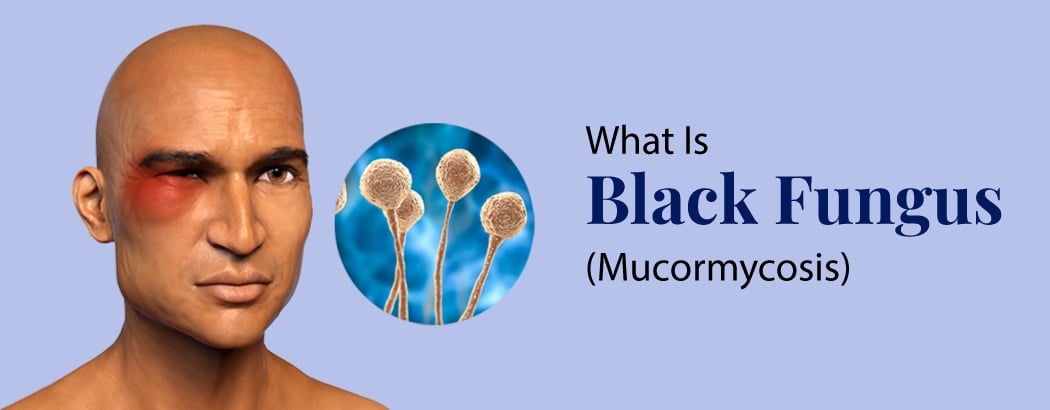What is Black Fungus (Mucormycosis)?
April 30, 2024

Overview
Fungal spores are a type of fungus that may live for a very long period. They are found in our surroundings, such as the soil and air, and we come into contact with them daily. Normally, they don’t cause any issues but can lead to illnesses like black fungus if there is a weakened immune system or an underlying medical issue.
Mucormycosis has long been a sickness, but during the pandemic in India in 2021, cases of the illness increased among hospitalised COVID-19 patients. This brought the condition into the public eye.
Table of Contents
- What is black fungus (mucormycosis)?
- Risk factors related to black fungus(mucormycosis)
- Black fungal symptoms
- Are black fungal symptoms preventable?
- Diagnosis
- Conclusion
- Frequently asked questions
What is Black Fungus (mucormycosis)?
Black fungus also known as mucormycosis, is an uncommon and severe fungal infection that is brought on by a fungus known as mucormycetes. These fungi are found in many types of environments. They can be seen living in compost piles, rotting wood, and decaying organic materials such as leaves.
When a person comes into touch with environmental fungus spores, they can contract mucormycosis. For instance, breathing in spores might result in lung or sinus infections. People with health issues or those who take medications that impair the body’s defences against infections and illnesses are more likely to experience black fungal symptoms.
Risk Factors Related to Black Fungus (mucormycosis)
Even though mucormycosis is uncommon, those with medical conditions or those on medications that impair immunity to disease are more likely to contract it. People with the following conditions have a higher risk of developing mucormycosis:
- Diabetes, particularly in cases of diabetic ketoacidosis
- Cancer
- Stem cell transplantation
- Organ transplantation
- Neutropenia (low white blood cell count)
- Prolonged use of corticosteroids
- Drug injection
- Hemochromatosis or iron overload—an excessive amount of iron in the body
- Burns, wounds, or surgery-related skin damage
- In cases of neonatal gastrointestinal mucormycosis, preterm and low birth weight are observed.
Black Fungal Symptoms
Depending on where the fungus is growing in your body, mucormycosis can cause different symptoms. These could consist of:
- Fever
- Cough
- Pain in the chest
- Blood in the stool
- Black lesions on the interior of the mouth or nasal bridge
- Shortness of breath
- Diarrhoea
- Facial swelling on one side
- Headache
- Sinus congestion
- Nausea and vomiting
- Bleeding in the stomach
The affected area of your skin may appear bloated, red, or blistered. It may become painful, heated, or turn black. The virus may also spread to other areas of the body via blood. This is referred to as disseminated mucormycosis. At this point, the fungus may impact the heart and spleen, among other organs. Severe cases may cause mental problems or perhaps put the patient in a coma and can even be fatal.
Can Black Fungal Symptoms be Prevented?
It is impossible to avoid inhaling or consuming fungus spores due to their constant presence in our surroundings, particularly those responsible for black fungus.
Several strategies can be taken to shield yourself from these surroundings and lessen the risks of contracting black fungal symptoms particularly if the body has a weakened immune system, but these are not foolproof.
These consist of:
- Use soap and water to thoroughly clean any skin wounds, particularly when exposed to dirt or dust.
- Steer clear of activities like gardening. It’s advisable to wear gloves and cover exposed areas of the skin while performing such outdoor activities.
- Avoiding areas with high levels of dust, such as construction sites. If unable to avoid dusty environments, the use of a respirator, which is a kind of face mask can be helpful.
- Avoiding areas with floodwaters or flooded structures, especially after natural disasters.
Diagnosis
A medical professional will examine you physically and discuss your symptoms with you. The following tests are typically carried out if they suspect you have mucormycosis:
- A biopsy
- Attempting to cultivate the fungus in a lab or search for it under a microscope by obtaining a sample of the nasal fluid or phlegm.
- Blood examinations
- Urine testing
- X-rays
- CT scans, or MRIs of the sinuses, lungs, or other body areas, depending on the location of the infection
- Endoscopies, if the patient exhibits gastrointestinal black fungal symptoms, a nasal endoscopy, examines the sinuses and nose.
Conclusion
Infections with mucormycosis are uncommon but extremely deadly, necessitating prompt medical attention. While it is not possible to completely avoid this infection, raising your immunity lowers your chance of contracting mucormycosis.
Modern medicine has made it possible to treat this easily. On the other hand, if the symptoms persist, an immediate visit to the healthcare institution is advisable.
Frequently Asked Questions
1. What is the black fungus or mucormycosis?
Mucormycosis is a rare but dangerous black fungal infection. It usually affects the sinuses, lungs, skin, and brain and is caused by a class of molds called mucormycetes.
2. Is it possible to survive mucormycosis?
If a diagnosis is delayed for longer than five days, the death rate increases.
3. Does black fungus, mucormycosis, spread easily?
The disease black fungus (Mucormycosis) is not contagious. Nevertheless, skin injuries or burns are a common way for this fungus to infiltrate your body. Additionally, the infection spreads from one part of your body to another and mixes with blood leading to dangerous diseases.
4. How can one test for mucormycosis?
Black fungus disease can be tested by performing a tissue biopsy, a process in which a small sample of the diseased tissue is inspected for signs of mucormycosis using a fungal culture in a lab setting or under a microscope. This technique may be performed by your doctor.
5. How is black fungus (mucormycosis) contracted?
Fungal spores in the environment can cause mucormycosis in humans. For instance, inhaling airborne spores can result in the lung or sinus types of the infection. Once the fungus penetrates the skin through a cut, burn, or other sort of skin injury, a skin infection may result.







